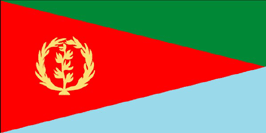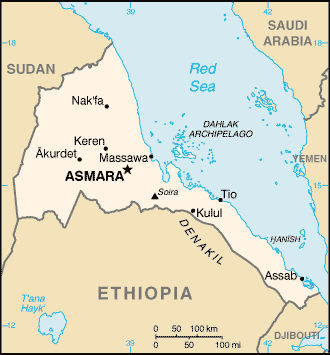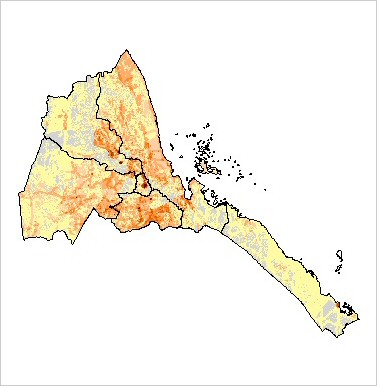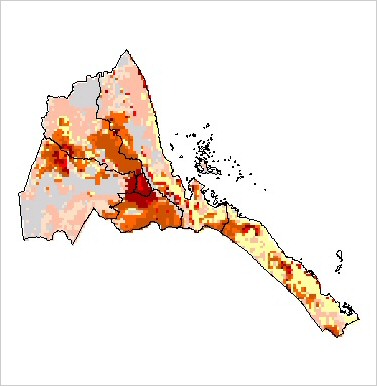|
|
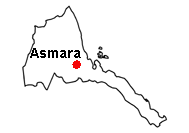 |
| |
back to top | ||
|
In 2004, the Cheetah was identified as extinct in Eritrea. |
|||
|
|
|||
|
|||
|
Background: Eritrea was awarded to Ethiopia in 1952 as part of a federation. Ethiopia's annexation of Eritrea as a province 10 years later sparked a 30-year struggle for independence that ended in 1991 with Eritrean rebels defeating governmental forces; independence was overwhelmingly approved in a 1993 referendum. A two-and-a-half-year border war with Ethiopia that erupted in 1998 ended under UN auspices in December 2000. Eritrea currently hosts a UN peacekeeping operation that is monitoring a 25 km-wide Temporary Security Zone on the border with Ethiopia. An international commission, organized to resolve the border dispute, posted its findings in 2002 but final demarcation is on hold due to Ethiopian objections. |
|||
| |
back to top |
|
Area: total: 121,320 sq km; land: 121,320 sq km; water: 0 sq km Climate: hot, dry desert strip along Red Sea coast; cooler and wetter in the central highlands (up to 61 cm of rainfall annually, heaviest June to September); semiarid in western hills and lowlands Terrain: dominated by extension of Ethiopian north-south trending highlands, descending on the east to a coastal desert plain, on the northwest to hilly terrain and on the southwest to flat-to-rolling plains Natural resources: gold, potash, zinc, copper, salt, possibly oil and natural gas, fish Land use: arable land: 4.78%; permanent crops: 0.03%; other: 95.19% (2005) Irrigated land: 210 sq km (2003) Natural hazards: frequent droughts; locust swarms Environment - current issues: deforestation; desertification; soil erosion; overgrazing; loss of infrastructure from civil warfare Environment - international agreements: party to: Biodiversity, Climate Change, Desertification, Endangered Species, Hazardous Wastes; signed, but not ratified: none of the selected agreements |
|
|
|
|
| |
back to top |
|
Population: 4,786,994 (July 2006 est.) Age structure: 0-14 years: 44% (male 1,059,458/female 1,046,955); 15-64 years: 52.5% (male 1,244,153/female 1,268,189); 65 years and over: 3.5% (male 82,112/female 86,127) (2006 est.) Median age: total: 17.8 years; male: 17.6 years; female: 18 years (2006 est.) Population growth rate: 2.47% (2006 est.) Infant mortality rate: total: 46.3 deaths/1,000 live births; male: 52.22 deaths/1,000 live births; female: 40.2 deaths/1,000 live births (2006 est.) Life expectancy at birth: total population: 59.03 years; male: 57.44 years; female: 60.66 years (2006 est.) Total fertility rate: 5.08 children born/woman (2006 est.) HIV/AIDS - adult prevalence rate: 2.7% (2003 est.) 60,000 (2003 est.) 60,000 (2003 est.) HIV/AIDS - people living with HIV/AIDS: 60,000 (2003 est.) HIV/AIDS - deaths: 6,300 (2003 est.)
|
|
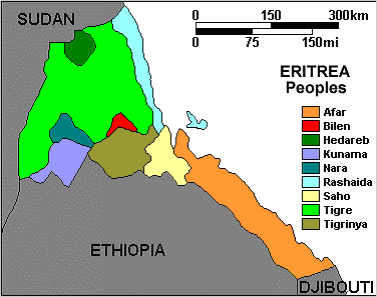 |
Ethnic groups: Tigrinya 50%, Tigre and Kunama 40%, Afar 4%, Saho (Red Sea coast dwellers) 3%, other 3% Religions: Muslim, Coptic Christian, Roman Catholic, Protestant Languages: Afar, Arabic, Tigre and Kunama, Tigrinya, other Cushitic languages |
|
Distribution of ethnic groups in Eritrea |
|
| back to top | |
|
Data Code: ER Government type: transitional
government Independence: 24 May 1993 (from Ethiopia) Legal system: primary basis is the Ethiopian legal code of 1957, with revisions; new civil, commercial, and penal codes have not yet been promulgated; also relies on customary and post-independence-enacted laws and, for civil cases involving Muslims, Sharia law Political pressure groups and leaders: Eritrean Islamic Jihad or EIJ (also including Eritrean Islamic Jihad Movement or EIJM (also known as the Abu Sihel Movement)); Eritrean Islamic Salvation or EIS (also known as the Arafa Movement); Eritrean Liberation Front or ELF [ABDULLAH Muhammed]; Eritrean National Alliance or ENA (a coalition including EIJ, EIS, ELF, and a number of ELF factions) [HERUY Tedla Biru]; Eritrean Public Forum or EPF [ARADOM Iyob] |
|
| back to top | |
|
Economy - overview: Since independence from Ethiopia in 1993, Eritrea has faced the economic problems of a small, desperately poor country. Like the economies of many African nations, the economy is largely based on subsistence agriculture, with 80% of the population involved in farming and herding. The Ethiopian-Eritrea war in 1998-2000 severely hurt Eritrea's economy. GDP growth fell to zero in 1999 and to -12.1% in 2000. The May 2000 Ethiopian offensive into northern Eritrea caused some $600 million in property damage and loss, including losses of $225 million in livestock and 55,000 homes. The attack prevented planting of crops in Eritrea's most productive region, causing food production to drop by 62%. Even during the war, Eritrea developed its transportation infrastructure, asphalting new roads, improving its ports, and repairing war-damaged roads and bridges. Since the war ended, the government has maintained a firm grip on the economy, expanding the use of the military and party-owned businesses to complete Eritrea's development agenda. Erratic rainfall and the delayed demobilization of agriculturalists from the military kept cereal production well below normal, holding down growth in 2002-06. Eritrea's economic future depends upon its ability to master social problems such as illiteracy, unemployment, and low skills, as well as the willingness to open its economy to private enterprise so that the diaspora's money and expertise can foster economic growth. GDP - real growth rate: 2% (2005 est.) GDP - composition by sector: agriculture: 9.9%; industry: 25.4%; services: 64.6% (2006 est.) Labor force: NA Labor force - by occupation: agriculture: 80%; industry and services: 20% Unemployment rate: NA% Population below poverty line: 50% (2004 est.) |
|
|
Agriculture - products: sorghum, lentils, vegetables, corn, cotton, tobacco, coffee, sisal; livestock, goats; fish Industries: food processing, beverages, clothing and textiles, light manufacturing, salt, cement, commercial ship repair Industrial production growth rate: NA% Exports: $17.65 million f.o.b. (2006 est.) Exports - commodities: livestock, sorghum, textiles, food, small manufactures (2000) Exports - partners: Italy 36.4%, US 13.8%, Belarus 6.8%, Germany 5.3%, UK 4.6% (2005) Imports: $701.8 million f.o.b. (2006 est.) Imports - commodities: machinery, petroleum products, food, manufactured goods (2000) Imports - partners: Germany 21.3%, Italy 19.5%, France 15.3%, US 12.3%, Ireland 7.9%, Jordan 5.5% (2005) Currency (code): nakfa (ERN) Exchange rates: nakfa (ERN) per US dollar - 14 (2006), 14.5 (2005), 13.788 (2004), 13.878 (2003), 13.958 (2002) |
|
| |
back to top |
|
Telephone system: general assessment: inadequate; domestic: inadequate; most telephones are in Asmara; government is seeking international tenders to improve the system (2002); international: country code - 291; note - international connections exist Radio broadcast stations: AM 2, FM NA, shortwave 2 (2000) Television broadcast stations: 2 (2006) Internet country code: .er Internet hosts: 1,088 (2006) Internet users: 70,000 (2005) |
|
| |
back to top |
|
Shoshani J. 2004. Paleozoogeography and neozoogeography of mammals in Eritrea |
